Monitoring the Spatiotemporal Dynamics of Habitat Quality and Its Driving Factors Based on the Coupled NDVI-InVEST Model: A Case Study from the Tianshan Mountains in Xinjiang, China
Abstract
1. Introduction
2. Materials and Methods
2.1. Study Area
2.2. Data Sources
2.3. Methods
2.3.1. Habitat Quality Evaluation
2.3.2. Terrain Factors
2.3.3. Spatial Autocorrelation and Hot/Cold Spot Analysis
2.3.4. Selection of Driving Factors
2.3.5. Geographical Detector Model
3. Results
3.1. Validation of Habitat Quality
3.2. Land-Use Change from 1995–2015
3.3. Spatiotemporal Change in Habitat Quality
3.4. The Spatial Heterogeneity of the Habitat Quality
3.5. Habitat Quality in Relation to Different PAs
3.6. Habitat Quality Variation in Terrain Gradient
3.7. Driving Factors of Habitat Quality
3.7.1. Comparison of Driving Factors in the Different Sub-Regions
3.7.2. Spatial Interactions between Driving Factors
4. Discussion
4.1. Climate Change and Anthropogenic Activity Implications
4.2. The Gap between Conservation Expectations and Reality
4.3. Limitations and Future Work
5. Conclusions
Author Contributions
Funding
Institutional Review Board Statement
Informed Consent Statement
Data Availability Statement
Conflicts of Interest
References
- Duraiappah, A.K.; Naeem, S.; Agardy, T.; Ash, N.J.; Cooper, H.D.; Díaz, S.; Faith, D.P.; Mace, G.; McNeely, J.A.; Mooney, H.A.; et al. Ecosystems and Human Well-Being: Biodiversity Synthesis; World Resources Institute: Washington, DC, USA, 2005; p. 86. [Google Scholar]
- Powers, R.P.; Jetz, W. Global habitat loss and extinction risk of terrestrial vertebrates under future land-use-change scenarios. Nat. Clim. Chang. 2019, 9, 323–329. [Google Scholar] [CrossRef]
- Heikkinen, R.K.; Kartano, L.; Leikola, N.; Aalto, J.; Aapala, K.; Kuusela, S.; Virkkala, R. High-latitude EU Habitats Directive species at risk due to climate change and land use. Glob. Ecol. Conserv. 2021, 28, e01664. [Google Scholar] [CrossRef]
- Moreira, M.; Fonseca, C.; Vergílio, M.; Calado, H.; Gil, A. Spatial assessment of habitat conservation status in a Macaronesian island based on the InVEST model: A case study of Pico Island (Azores, Portugal). Land Use Policy 2018, 78, 637–649. [Google Scholar] [CrossRef]
- Maes, J.; Paracchini, M.L.; Zulian, G.; Dunbar, M.B.; Alkemade, R. Synergies and trade-offs between ecosystem service supply, biodiversity, and habitat conservation status in Europe. Biol. Conserv. 2012, 155, 1–12. [Google Scholar] [CrossRef]
- Payne, D.; Spehn, E.M.; Snethlage, M.; Fischer, M. Opportunities for research on mountain biodiversity under global change. Curr. Opin. Environ. Sustain. 2017, 29, 40–47. [Google Scholar] [CrossRef]
- Yu, Y.; Li, J.; Zhou, Z.; Ma, X.; Zhang, X. Response of multiple mountain ecosystem services on environmental gradients: How to respond, and where should be priority conservation? J. Clean. Prod. 2021, 278, 123264. [Google Scholar] [CrossRef]
- Kohler, T.; Maselli, D. (Eds.) Mountains and Climate Change. From Understanding to Action, 3rd ed.; Geographica Bernensia: Bern, Switzerland, 2012. [Google Scholar]
- Vincent, C.; Fernandes, R.F.; Cardoso, A.R.; Broennimann, O.; Di Cola, V.; D’Amen, M.; Ursenbacher, S.; Schmidt, B.R.; Pradervand, J.-N.; Pellissier, L.; et al. Climate and land-use changes reshuffle politically-weighted priority areas of mountain biodiversity. Glob. Ecol. Conserv. 2019, 17, e00589. [Google Scholar] [CrossRef]
- Grêt-Regamey, A.; Weibel, B. Global assessment of mountain ecosystem services using earth observation data. Ecosyst. Serv. 2020, 46, 101213. [Google Scholar] [CrossRef]
- Bernardino, P.N.; De Keersmaecker, W.; Fensholt, R.; Verbesselt, J.; Somers, B.; Horion, S.; Silva, T. Global-scale characterization of turning points in arid and semi-arid ecosystem functioning. Glob. Ecol. Biogeogr. 2020, 29, 1230–1245. [Google Scholar] [CrossRef]
- McNeely, J.A. Biodiversity in arid regions: Values and perceptions. J. Arid. Environ. 2003, 54, 61–70. [Google Scholar] [CrossRef]
- Zhang, H.X.; Zhang, M.L. Spatial Patterns of Species Diversity and Phylogenetic Structure of Plant Communities in the Tianshan Mountains, Arid Central Asia. Front. Plant Sci. 2017, 8, 2134. [Google Scholar] [CrossRef] [PubMed]
- Fan, M.; Xu, J.; Chen, Y.; Li, W. Reconstructing high-resolution temperature for the past 40 years in the Tianshan Mountains, China based on the Earth system data products. Atmos. Res. 2021, 253, 105493. [Google Scholar] [CrossRef]
- Chen, Y.; Li, W.; Deng, H.; Fang, G.; Li, Z. Changes in Central Asia’s Water Tower: Past, Present and Future. Sci. Rep. 2016, 6, 35458. [Google Scholar] [CrossRef]
- Wei, H.; Xiong, L.; Tang, G.; Strobl, J.; Xue, K. Spatial–temporal variation of land use and land cover change in the glacial affected area of the Tianshan Mountains. Catena 2021, 202, 105256. [Google Scholar] [CrossRef]
- Li, Y.; Chen, Y.; Sun, F.; Li, Z. Recent vegetation browning and its drivers on Tianshan Mountain, Central Asia. Ecol. Indic. 2021, 129, 107912. [Google Scholar] [CrossRef]
- Zhao, W.Y.; Li, J.L.; Qi, J.G. Changes in vegetation diversity and structure in response to heavy grazing pressure in the northern Tianshan Mountains, China. J. Arid. Environ. 2007, 68, 465–479. [Google Scholar] [CrossRef]
- Sharp, R.; Tallis, H.T.; Ricketts, T.; Guerry, A.D.; Wood, S.A.; Chaplin-Kramer, R.; Nelson, E.; Ennaanay, D.; Wolny, S.; Olwero, N.; et al. InVEST+ VERSION+ User’s Guide; The Natural Capital Project; Stanford University: Stanford, CA, USA; University of Minnesota: Minneapolis, MN, USA; The Nature Conservancy, and World Wildlife Fund: Arlington, VT, USA, 2015. [Google Scholar]
- Riedler, B.; Lang, S. A spatially explicit patch model of habitat quality, integrating spatio-structural indicators. Ecol. Indic. 2018, 94, 128–141. [Google Scholar] [CrossRef]
- Sun, X.; Jiang, Z.; Liu, F.; Zhang, D. Monitoring spatio-temporal dynamics of habitat quality in Nansihu Lake basin, eastern China, from 1980 to 2015. Ecol. Indic. 2019, 102, 716–723. [Google Scholar] [CrossRef]
- Zhu, C.; Zhang, X.; Zhou, M.; He, S.; Gan, M.; Yang, L.; Wang, K. Impacts of urbanization and landscape pattern on habitat quality using OLS and GWR models in Hangzhou, China. Ecol. Indic. 2020, 117, 106654. [Google Scholar] [CrossRef]
- He, J.; Huang, J.; Li, C. The evaluation for the impact of land use change on habitat quality: A joint contribution of cellular automata scenario simulation and habitat quality assessment model. Ecol. Model. 2017, 366, 58–67. [Google Scholar] [CrossRef]
- Sallustio, L.; De Toni, A.; Strollo, A.; Di Febbraro, M.; Gissi, E.; Casella, L.; Geneletti, D.; Munafò, M.; Vizzarri, M.; Marchetti, M. Assessing habitat quality in relation to the spatial distribution of protected areas in Italy. J. Environ. Manag. 2017, 201, 129–137. [Google Scholar] [CrossRef] [PubMed]
- Di Febbraro, M.; Sallustio, L.; Vizzarri, M.; De Rosa, D.; De Lisio, L.; Loy, A.; Eichelberger, B.A.; Marchetti, M. Expert-based and correlative models to map habitat quality: Which gives better support to conservation planning? Glob. Ecol. Conserv. 2018, 16, e00513. [Google Scholar] [CrossRef]
- Nagendra, H.; Lucas, R.; Honrado, J.P.; Jongman, R.H.G.; Tarantino, C.; Adamo, M.; Mairota, P. Remote sensing for conservation monitoring: Assessing protected areas, habitat extent, habitat condition, species diversity, and threats. Ecol. Indic. 2013, 33, 45–59. [Google Scholar] [CrossRef]
- Pettorelli, N.; Ryan, S.; Mueller, T.; Bunnefeld, N.; Jedrzejewska, B.; Lima, M.; Kausrud, K. The Normalized Difference Vegetation Index (NDVI): Unforeseen successes in animal ecology. Clim. Res. 2011, 46, 15–27. [Google Scholar] [CrossRef]
- Aizen, V.; Aizen, E.; Melack, J.; Dozier, J. Climatic and Hydrologic Changes in the Tien Shan, Central Asia. J. Clim. 1997, 10, 1393–1404. [Google Scholar] [CrossRef]
- Mittermeier, R.A.; Turner, W.R.; Larsen, F.W.; Brooks, T.M.; Gascon, C. Global Biodiversity Conservation: The Critical Role of Hotspots. In Biodiversity Hotspots; Springer: Berlin/Heidelberg, Germany, 2011; pp. 3–22. [Google Scholar] [CrossRef]
- Olson, D.M.; Dinerstein, E. The Global 200: Priority ecoregions for global conservation. Ann. Mo. Bot. Gard. 2002, 89, 199–224. [Google Scholar] [CrossRef]
- Ministry of Ecology and Environment of People’s Republic of China. China National Biodiversity Conservation Strategy and Action Plan (2011–2030); China Environmental Science Press: Beijing, China, 2010.
- Shui, Y.; Lu, H.; Wang, H.; Yan, Y.; Wu, G. Assessment of habitat quality on the basis of land cover and NDVI changes in Lhasa River Basin (in Chinese). Acta Ecol. Sin. 2018, 38, 8949–8954. [Google Scholar] [CrossRef]
- Zhao, X.; Wang, J.; Su, J.; Sun, W.; Jin, W. Assessment of habitat quality and degradation degree based on InVEST model and Moran index in Gansu Province, China. Trans. Chin. Soc. Agric. Eng. 2020, 36, 301–308. (In Chinese) [Google Scholar] [CrossRef]
- Liu, F.T.; Xu, E.Q. Comparison of spatial-temporal evolution of habitat quality between Xinjiang Corps and Non-corps Region based on land use. Chin. J. Appl. Ecol. 2020, 31, 2341–2351. (In Chinese) [Google Scholar] [CrossRef]
- Xue, L.; Zhu, B.; Wu, Y.; Wei, G.; Liao, S.; Yang, C.; Wang, J.; Zhang, H.; Ren, L.; Han, Q. Dynamic projection of ecological risk in the Manas River basin based on terrain gradients. Sci. Total Environ. 2019, 653, 283–293. [Google Scholar] [CrossRef]
- McBratney, A.; Field, D.J.; Koch, A. The dimensions of soil security. Geoderma 2014, 213, 203–213. [Google Scholar] [CrossRef]
- Hülber, K.; Kuttner, M.; Moser, D.; Rabitsch, W.; Schindler, S.; Wessely, J.; Gattringer, A.; Essl, F.; Dullinger, S. Habitat availability disproportionally amplifies climate change risks for lowland compared to alpine species. Glob. Ecol. Conserv. 2020, 23, e01113. [Google Scholar] [CrossRef]
- Liu, C.; Wang, C.; Liu, L. Spatio-temporal variation on habitat quality and its mechanism within the transitional area of the Three Natural Zones: A case study in Yuzhong county. Geogr. Res. 2018, 37, 419–432. (In Chinese) [Google Scholar] [CrossRef]
- Fang, L.; Wang, L.; Chen, W.; Sun, J.; Cao, Q.; Wang, S.; Wang, L. Identifying the impacts of natural and human factors on ecosystem service in the Yangtze and Yellow River Basins. J. Clean. Prod. 2021, 314, 127995. [Google Scholar] [CrossRef]
- Wang, J.-F.; Zhang, T.-L.; Fu, B.-J. A measure of spatial stratified heterogeneity. Ecol. Indic. 2016, 67, 250–256. [Google Scholar] [CrossRef]
- Song, Y.; Wang, J.; Ge, Y.; Xu, C. An optimal parameters-based geographical detector model enhances geographic characteristics of explanatory variables for spatial heterogeneity analysis: Cases with different types of spatial data. GISci. Remote Sens. 2020, 57, 593–610. [Google Scholar] [CrossRef]
- Zhang, H.; Qian, Y.; Wu, Z.; Wang, Z. Vegetation-environment relationships between northern slope of Karlik Mountain and Naomaohu Basin, East Tianshan Mountains. Chin. Geogr. Sci. 2012, 22, 288–301. [Google Scholar] [CrossRef]
- Yang, Y. Evolution of habitat quality and association with land-use changes in mountainous areas: A case study of the Taihang Mountains in Hebei Province, China. Ecol. Indic. 2021, 129, 107967. [Google Scholar] [CrossRef]
- De Alban, J.D.T.; Leong, B.P.I.; Venegas-Li, R.; Connette, G.M.; Jamaludin, J.; Latt, K.T.; Oswald, P.; Reeder, C.; Webb, E.L. Conservation beyond the existing protected area network is required to improve species and habitat representation in a global biodiversity hotspot. Biol. Conserv. 2021, 257, 109105. [Google Scholar] [CrossRef]
- Wang, T.; Wu, P.; Ge, Q.; Ning, Z. Ticket prices and revenue levels of tourist attractions in China: Spatial differentiation between prefectural units. Tour. Manag. 2021, 83, 104214. [Google Scholar] [CrossRef]
- Xinjiang Uygur Autonomous Region Development and Reform Commission; Xinjiang Uygur Autonomous Region Tourism Development Commission. Xinjiang Uygur Autonomous Region Thirteenth Five-Year Plan for Tourism Development; Xinjiang Uygur Autonomous Region Development and Reform Commission; Xinjiang Uygur Autonomous Region Tourism Development Commission: Urumqi, China, 2017. [Google Scholar]
- Jost, E.; Schonhart, M.; Skalsky, R.; Balkovic, J.; Schmid, E.; Mitter, H. Dynamic soil functions assessment employing land use and climate scenarios at regional scale. J. Environ. Manag. 2021, 287, 112318. [Google Scholar] [CrossRef] [PubMed]
- Albaladejo, J.; Díaz-Pereira, E.; de Vente, J. Eco-Holistic Soil Conservation to support Land Degradation Neutrality and the Sustainable Development Goals. Catena 2021, 196, 104823. [Google Scholar] [CrossRef]
- Manes, S.; Costello, M.J.; Beckett, H.; Debnath, A.; Devenish-Nelson, E.; Grey, K.-A.; Jenkins, R.; Khan, T.M.; Kiessling, W.; Krause, C.; et al. Endemism increases species’ climate change risk in areas of global biodiversity importance. Biol. Conserv. 2021, 257, 109070. [Google Scholar] [CrossRef]
- Donovan, M.; Monaghan, R. Impacts of grazing on ground cover, soil physical properties and soil loss via surface erosion: A novel geospatial modelling approach. J. Environ. Manag. 2021, 287, 112206. [Google Scholar] [CrossRef]
- Zhang, L.; Luo, Z.; Mallon, D.; Li, C.; Jiang, Z. Biodiversity conservation status in China’s growing protected areas. Biol. Conserv. 2017, 210, 89–100. [Google Scholar] [CrossRef]
- Li, X.; Clinton, N.; Si, Y.; Liao, J.; Liang, L.; Gong, P. Projected impacts of climate change on protected birds and nature reserves in China. Sci. Bull. 2015, 60, 1644–1653. [Google Scholar] [CrossRef]
- Tanner-McAllister, S.L.; Rhodes, J.; Hockings, M. Managing for climate change on protected areas: An adaptive management decision making framework. J. Environ. Manag. 2017, 204, 510–518. [Google Scholar] [CrossRef]


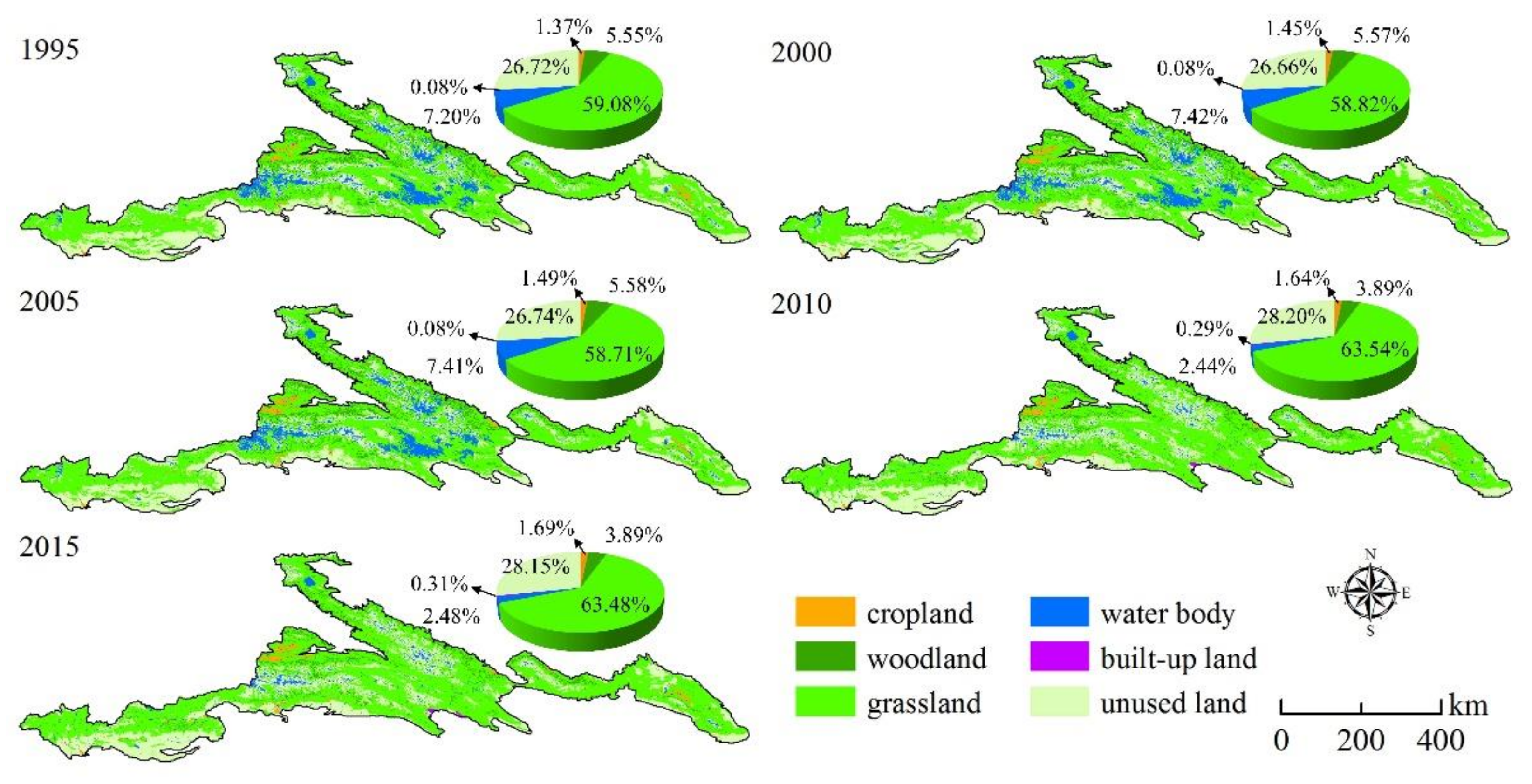
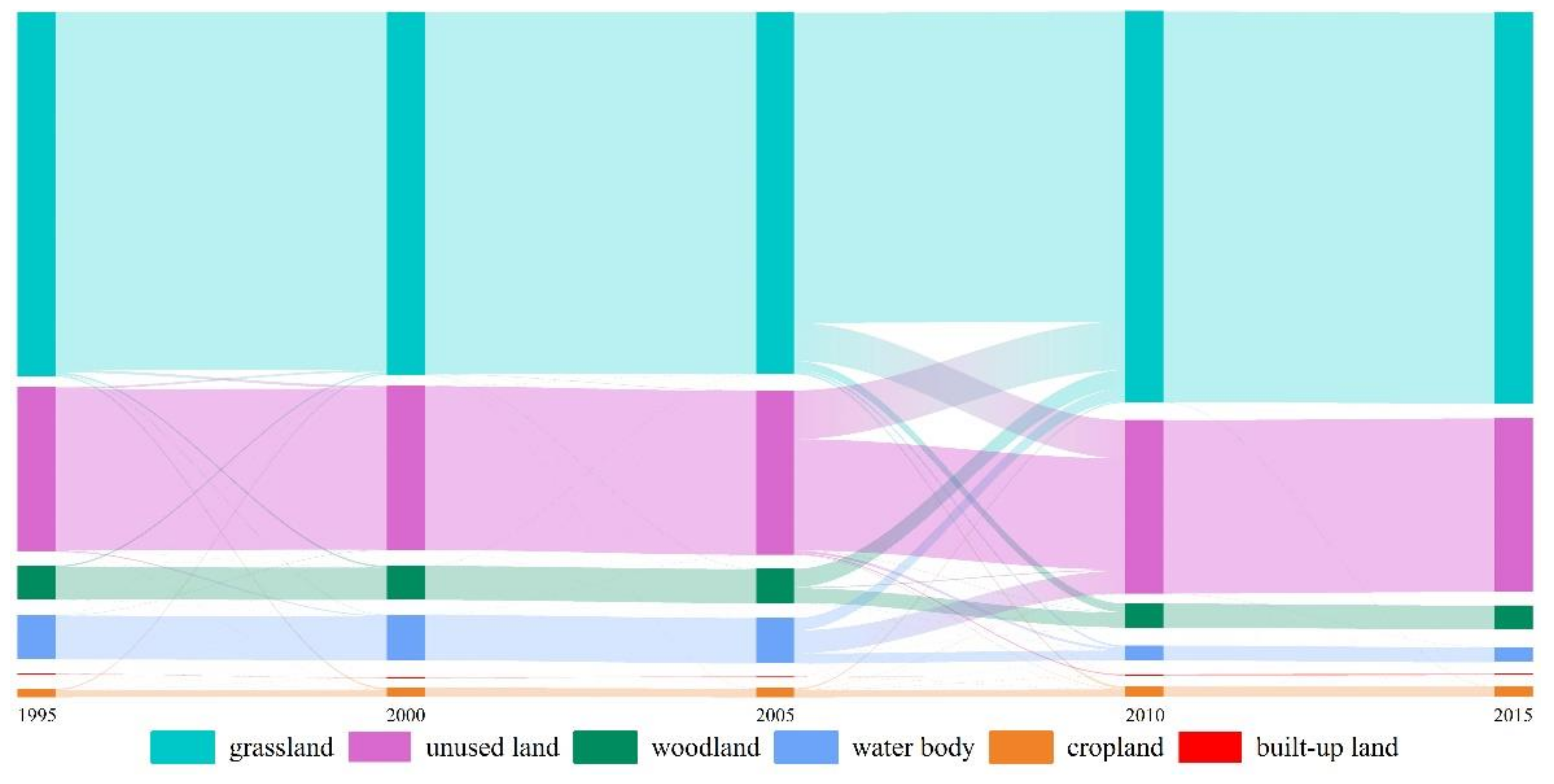
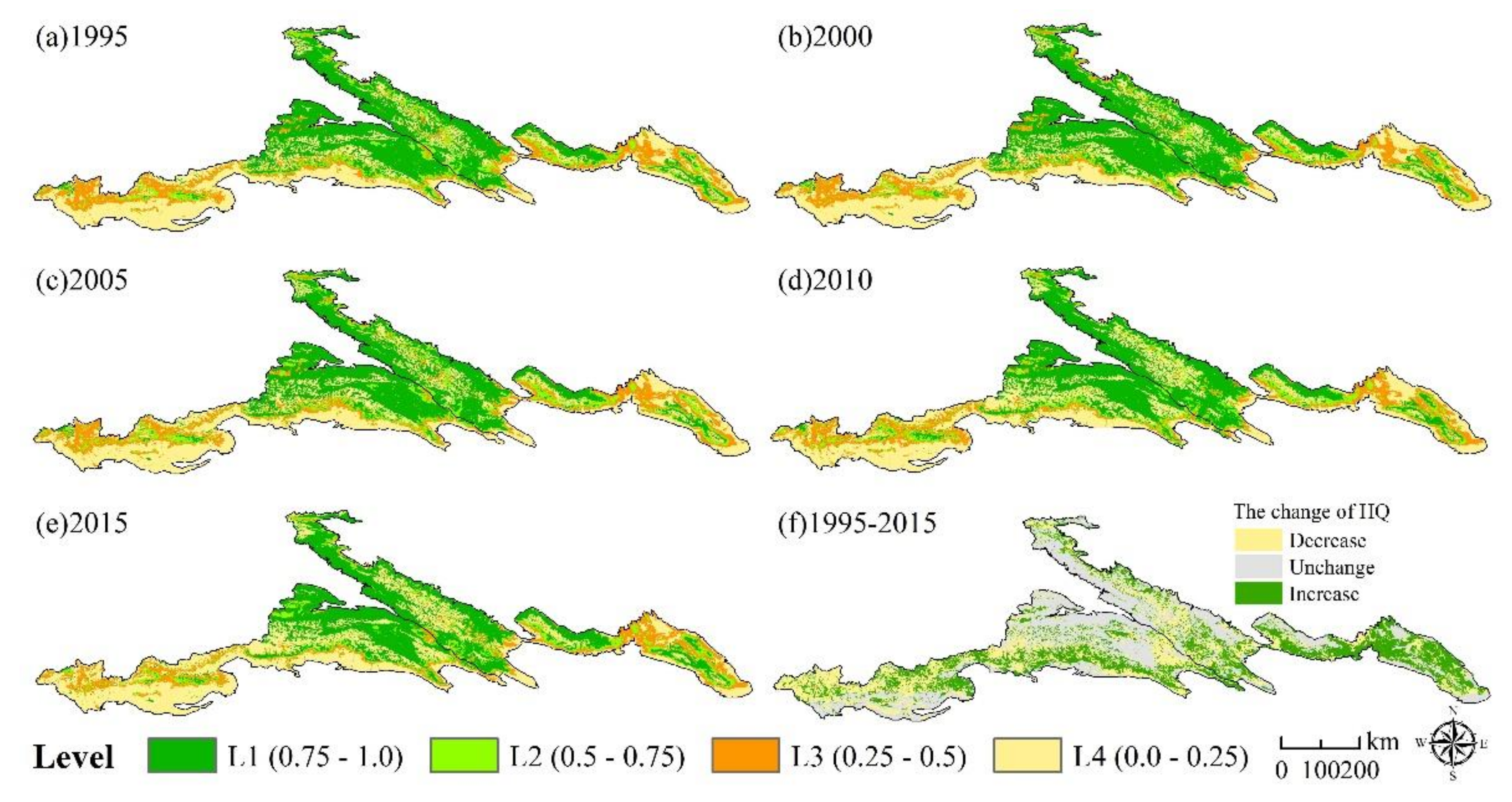
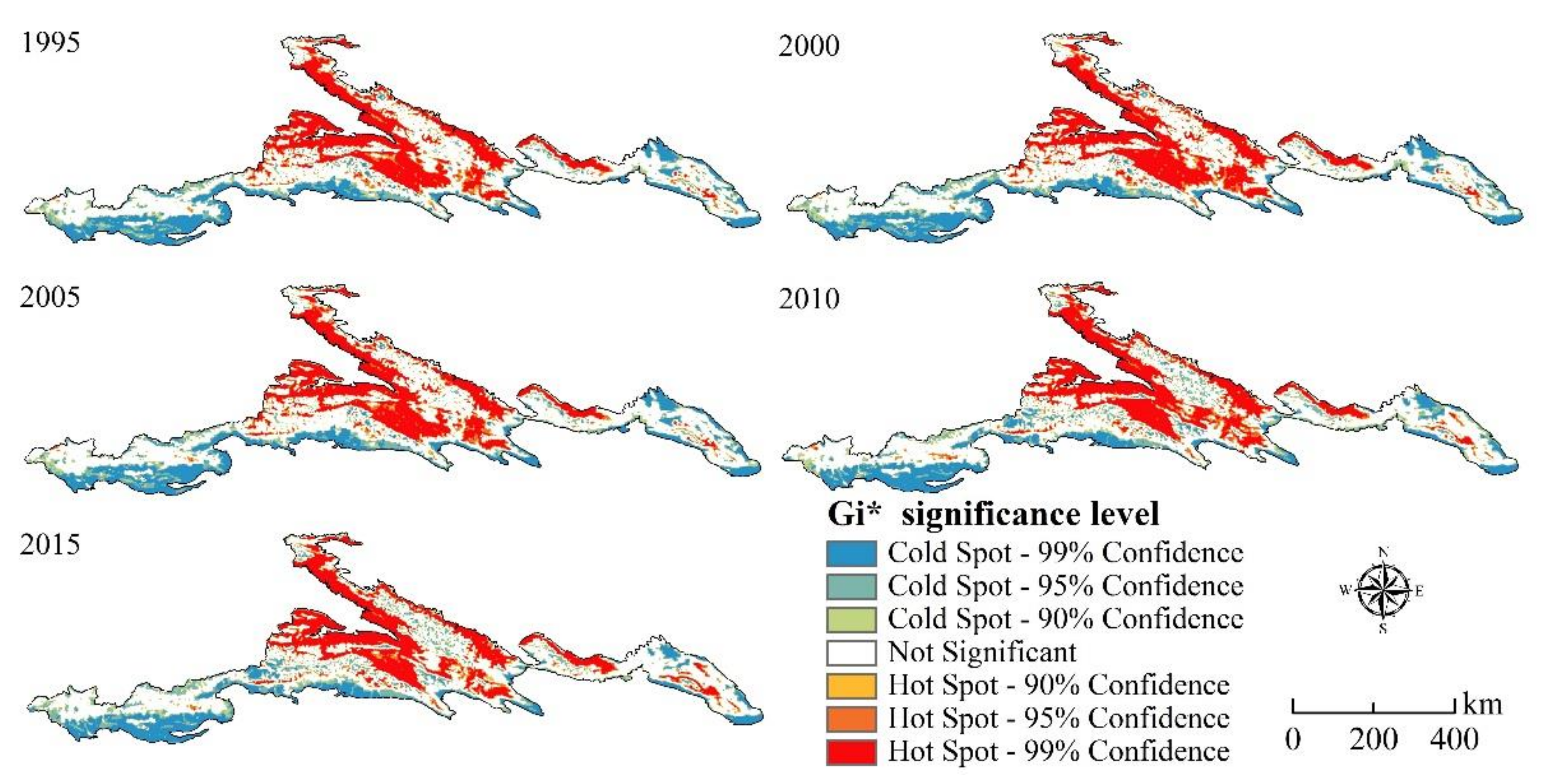

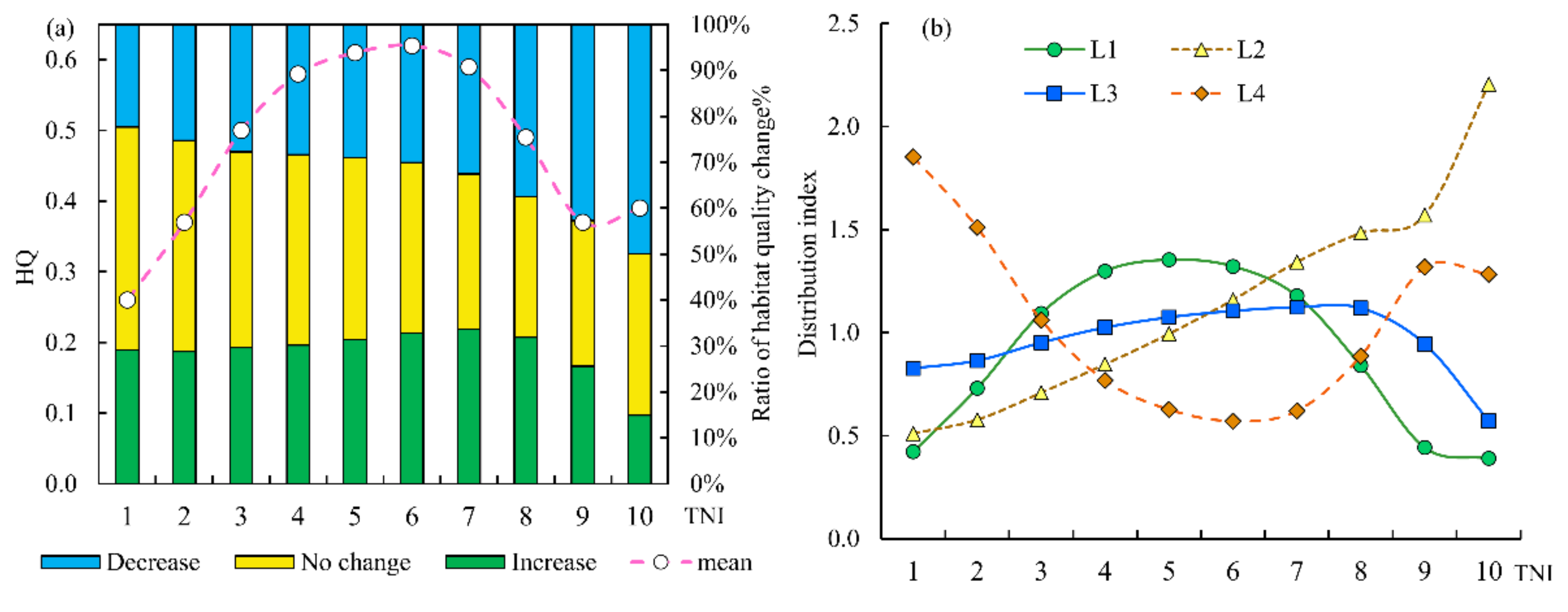

| Threats | Maximum Influence Distance/km | Weight | Spatial Decay Type |
|---|---|---|---|
| Cropland | 8 | 0.7 | linear |
| Urban land | 10 | 1 | linear |
| Rural residential | 6 | 0.6 | linear |
| Other construction land | 8 | 0.8 | linear |
| Railway | 4 | 0.5 | linear |
| Highway | 3 | 0.4 | linear |
| Land-Use Code | Habitat | Cropland | Urban Land | Rural Residential | Other Construction Land | Railway | Highway |
|---|---|---|---|---|---|---|---|
| 10 | 0.3 | 0.0 | 0.6 | 0.4 | 0.3 | 0.5 | 0.4 |
| 21 | 1 | 0.8 | 0.9 | 0.8 | 0.8 | 0.8 | 0.7 |
| 22 | 0.9 | 0.6 | 0.7 | 0.6 | 0.5 | 0.6 | 0.5 |
| 23 | 0.8 | 0.7 | 0.8 | 0.7 | 0.6 | 0.8 | 0.7 |
| 24 | 0.7 | 0.7 | 0.8 | 0.7 | 0.6 | 0.7 | 0.6 |
| 31 | 0.9 | 0.5 | 0.6 | 0.5 | 0.4 | 0.5 | 0.6 |
| 32 | 0.8 | 0.6 | 0.7 | 0.6 | 0.4 | 0.5 | 0.6 |
| 33 | 0.7 | 0.7 | 0.8 | 0.7 | 0.6 | 0.5 | 0.6 |
| 41 | 1 | 0.1 | 0.7 | 0.6 | 0.5 | 0.5 | 0.4 |
| 42 | 1 | 0.1 | 0.7 | 0.6 | 0.5 | 0.5 | 0.4 |
| 43 | 1 | 0.1 | 0.7 | 0.6 | 0.5 | 0.5 | 0.4 |
| 44 | 1 | 0.1 | 0.1 | 0.2 | 0.1 | 0.5 | 0.4 |
| 45 | 0.8 | 0.7 | 0.8 | 0.6 | 0.5 | 0.5 | 0.4 |
| 51 | 0 | 0 | 0 | 0 | 0 | 0 | 0 |
| 52 | 0 | 0 | 0 | 0 | 0 | 0 | 0 |
| 53 | 0 | 0 | 0 | 0 | 0 | 0 | 0 |
| 61 | 0 | 0 | 0 | 0 | 0 | 0 | 0 |
| 62 | 0 | 0 | 0 | 0 | 0 | 0 | 0 |
| 63 | 0.1 | 0.1 | 0.1 | 0.1 | 0.1 | 0.2 | 0.2 |
| 64 | 0.8 | 0.1 | 0.5 | 0.6 | 0.4 | 0.5 | 0.7 |
| 65 | 0.1 | 0.1 | 0.1 | 0.1 | 0.1 | 0.2 | 0.2 |
| 66 | 0 | 0 | 0 | 0 | 0 | 0 | 0 |
| 67 | 0 | 0 | 0 | 0 | 0 | 0 | 0 |
| Index | Code | Unit | Data Source and Calculation |
|---|---|---|---|
| Soil type | SOL | - | Data from RESDC |
| Annual mean precipitation | PRE | mm | Data from RESDC |
| Annual mean temperature | TEM | °C | Data from RESDC |
| Elevation | ELE | m | Data from the Geospatial Data Cloud (http://www.gscloud.cn, accessed on 21 April 2022) |
| Relief degree of land surface | RDLS | - | Extract from DEM |
| Land-use type | LAND | - | Data from RESDC |
| Gross domestic product | GPD | 104CNY/km2 | Data from RESDC |
| Population density | PD | person/km2 | Data from RESDC |
| Distance to tourism attractions | TOU | m | The tourism attractions were obtained from the Department of Culture and Tourism of the Xinjiang Uygur Autonomous Region. It was calculated by ArcGIS “Euclidean distance” tool. |
| Grazing intensity | GI | heads/km2 | The livestock data was obtained from the XinJiang Statistical Yearbook. The grazing intensity was calculated based on literature (Li et al., 2014). |
| Description | Interaction |
|---|---|
| q(X1∩X2) < Min(q(X1), q(X2)) | Weaken, nonlinear |
| Min(q(X1), q(X2)) < q(X1∩X2) < Max(q(X1), q(X2)) | Weaken, univariate, nonlinear |
| q(X1∩X2) > Max(q(X1), q(X2)) | Enhance, linear, bivariate |
| q(X1∩X2) = q(X1) + q(X2) | Independent |
| q(X1∩X2) > q(X1) + q(X2) | Enhance, nonlinear |
| Classification | Level | Value | Area (%) | ||||
|---|---|---|---|---|---|---|---|
| 1995 | 2000 | 2005 | 2010 | 2015 | |||
| Very important habitat | L1 | 0.75~1.0 | 37.08 | 37.76 | 36.15 | 37.05 | 35.23 |
| Important habitat | L2 | 0.5~0.75 | 10.65 | 9.60 | 11.78 | 10.87 | 10.69 |
| Moderately important habitat | L3 | 0.25~0.5 | 16.86 | 15.76 | 16.47 | 15.29 | 14.98 |
| General habitat | L4 | 0.0~0.25 | 35.41 | 36.88 | 35.61 | 36.78 | 39.10 |
| Year | Zone | Main Interaction Detector |
|---|---|---|
| 1995 | TTS | SOL∩LAND, GI∩LAND, GI∩SOL |
| ETS | SOL∩LAND, GDP∩SOL, PRE∩LAND | |
| NTS | SOL∩LAND, PRE∩LAND, GI∩LAND | |
| MTS | SOL∩LAND, GI∩SOL, ELE∩SOL | |
| 2000 | TTS | SOL∩LAND, PRE∩LAND, GI∩SOL |
| ETS | SOL∩LAND, GDP∩SOL, PD∩SOL | |
| NTS | SOL∩LAND, PRE∩LAND, GI∩LAND | |
| MTS | GI∩SOL, SOL∩LAND, ELE∩PRE | |
| 2005 | TTS | SOL∩LAND, GI∩SOL, GDP∩SOL |
| ETS | GDP∩SOL, SOL∩LAND, PD∩SOL | |
| NTS | SOL∩LAND, ELE∩LAND, GI∩LAND | |
| MTS | SOL∩LAND, GI∩SOL, ELE∩SOL | |
| 2010 | TTS | SOL∩LAND, ELE∩SOL, GDP∩SOL |
| ETS | SOL∩LAND, GDP∩SOL, PD∩SOL | |
| NTS | SOL∩LAND, PRE∩LAND, GI∩LAND | |
| MTS | ELE∩SOL, GI∩SOL, GDP∩SOL | |
| 2015 | TTS | SOL∩LAND, ELE∩SOL, GDP∩SOL |
| ETS | SOL∩LAND, ELE∩SOL, PD∩SOL | |
| NTS | SOL∩LAND, ELE∩LAND, TEM∩LAND | |
| MTS | ELE∩SOL, GI∩SOL, ELE∩PRE |
Publisher’s Note: MDPI stays neutral with regard to jurisdictional claims in published maps and institutional affiliations. |
© 2022 by the authors. Licensee MDPI, Basel, Switzerland. This article is an open access article distributed under the terms and conditions of the Creative Commons Attribution (CC BY) license (https://creativecommons.org/licenses/by/4.0/).
Share and Cite
Lu, Y.; Zhao, J.; Qi, J.; Rong, T.; Wang, Z.; Yang, Z.; Han, F. Monitoring the Spatiotemporal Dynamics of Habitat Quality and Its Driving Factors Based on the Coupled NDVI-InVEST Model: A Case Study from the Tianshan Mountains in Xinjiang, China. Land 2022, 11, 1805. https://doi.org/10.3390/land11101805
Lu Y, Zhao J, Qi J, Rong T, Wang Z, Yang Z, Han F. Monitoring the Spatiotemporal Dynamics of Habitat Quality and Its Driving Factors Based on the Coupled NDVI-InVEST Model: A Case Study from the Tianshan Mountains in Xinjiang, China. Land. 2022; 11(10):1805. https://doi.org/10.3390/land11101805
Chicago/Turabian StyleLu, Yayan, Junhong Zhao, Jianwei Qi, Tianyu Rong, Zhi Wang, Zhaoping Yang, and Fang Han. 2022. "Monitoring the Spatiotemporal Dynamics of Habitat Quality and Its Driving Factors Based on the Coupled NDVI-InVEST Model: A Case Study from the Tianshan Mountains in Xinjiang, China" Land 11, no. 10: 1805. https://doi.org/10.3390/land11101805
APA StyleLu, Y., Zhao, J., Qi, J., Rong, T., Wang, Z., Yang, Z., & Han, F. (2022). Monitoring the Spatiotemporal Dynamics of Habitat Quality and Its Driving Factors Based on the Coupled NDVI-InVEST Model: A Case Study from the Tianshan Mountains in Xinjiang, China. Land, 11(10), 1805. https://doi.org/10.3390/land11101805









